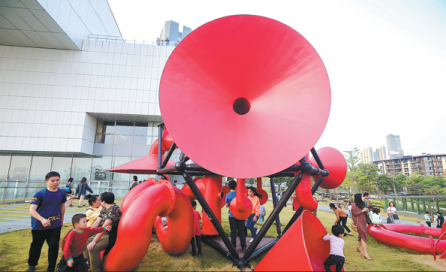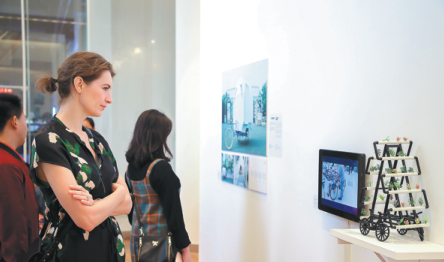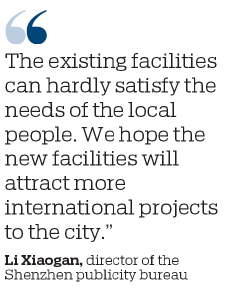Shenzhen plans to become regional center for culture

Shenzhen is well-known for being a technological and innovative powerhouse in China, but local officials want to ensure that is not the only thing the city is known for. Laterly, they have been putting cultural projects into focus.
"The city aims to become a regional cultural center and an international cultural innovation pioneer," said Li Xiaogan, director of the Shenzhen publicity bureau.
The city, once a fishing town in South China's Guangdong province, is one of China's most well-known economic miracles over the past 40 years. Today, its gross domestic product ranks third among cities in the Chinese mainland, following Beijing and Shanghai.
The government's goals in terms of culture were specified in a guideline issued in July promoting the quality development of cultural creativity and design in Shenzhen.
According to the guideline, cultural creativity industries in Shenzhen will generate at least 100 billion yuan ($14.2 billion) in revenue by 2020, which will be further increased to 300 billion yuan by 2035.
The number of institutions and companies involved in the industries will rise to 15,000 by 2020 with 100,000 employees. The number of employees will further rise to 150,000 by 2035, according to the guideline.
Leap in cultural services
"Taking the whole world in view, cities with sound economic structures and strong innovation capabilities are usually coupled with booming culture," Li said.
Citing Paris as an example, Li said the French capital is a leading city in terms of GDP worldwide, but is better known for its rich cultural and artistic atmosphere. And New York, a relatively newer city, has developed modern art and culture, such as abstract and pop art, making it a cultural center in a little over a century, he observed.
"Shenzhen only had a single piano, a theater and a drama group 40 years ago, and it was located far away from cultural centers in Central China," Li said, explaining why the city was called a "cultural desert" in the 1980s.
However, once the economy started to grow rapidly, the local government placed a greater priority on cultural development, he noted.
When the city decided to relocate its city government in the late 1990s, some landmark cultural buildings were planned to be built close to the new government building in the central area of the city to highlight the importance of culture.
They include the central book mall, a concert hall, a city library, a youth palace and a modern art museum, which are all functioning well, Li said.
In November 2008, Shenzhen was recognized as a "City of Design" by the United Nations Educational, Scientific and Cultural Organization, becoming the first city on the Chinese mainland and the sixth city in the world to receive the honor.
In October 2013, the city was named by UNESCO as a global role model for the promotion of reading, the highest recognition in this category.
In January 2016, the city issued a five-year plan for cultural innovation and development, in which the local government is required to finish 153 major projects by 2020. The latest statistics indicate that about 92 percent of the projects have been completed.
The city's cultural events calender was launched in May 2017. An increasing number of international events have been put on the list, including the Shenzhen Design Award for Young Talents in Cooperation with UNESCO Creative Cities Network in February, Shenzhen Belt and Road International Music Festival in March, Shenzhen Design Week and Shenzhen Global Design Award in April, China (Shenzhen) International Cultural Industries Fair in May, Shenzhen Dance Month in July, Shenzhen (International) Science Film Week in September, Shenzhen Reading Month in November and the Shenzhen Creative December event.
The local government announced in late 2018 it is investing a total of 20 billion yuan to build a group of new cultural facilities in the next three years. They include a new opera house, a creative design museum, a new art museum and an academy of music.
"The existing facilities can hardly satisfy the needs of the local people. We hope the new facilities will attract more international projects to the city," Li said.
Nurturing global players
While people enjoy diversified artistic and cultural activities in the city, companies also benefit from the government's cultural policies.
Government statistics show the added value of the cultural creativity industry in Shenzhen reached 262.2 billion yuan last year, up 16.8 percent from a year before. It contributed about 11 percent to the city's GDP.
There are more than 50,000 cultural companies in Shenzhen, employing about 1 million workers, of which more than 40 were listed on domestic and overseas stock markets, official figures show.
Fantawild Holdings, one of China's top 30 cultural companies based in Shenzhen, is using new technologies to produce its latest cultural products.
"Cultural development has become more closely integrated with technologies," said Ding Liang, executive president of Fantawild.
The company is among the early players engaged in the development of new technology movies, according to Ding. When it successfully developed the first 4D dome-screened movie, the company applied for invention patents in both China and the United States, he said, adding that both the special system and movies will target overseas markets.
The company has exported the self-developed special film systems to more than 40 countries and regions. It has also produced films to cater to the equipment and exported more than 20 films annually, according to the company.
Cultural companies in Shenzhen are also attempting to combine culture with tourism, finance and arts.
China Merchants Culture Industries, a subsidiary under the listed company China Merchants Shekou and 147-year-old China Merchants Group, is focusing on cultural industry investment and operation.
General Manger Lai Qiaozhen said the company was using special multimedia effects to combine traditional Chinese painting with popular scientific knowledge in one of its shows.
chenhong@chinadaily.com.cn


























